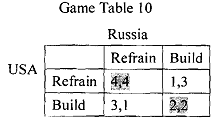Multiple Equilibria in Pure Strategy:
Although many examples provided in this unit so far give the impression that each game has a single solution, it is possible that there may be situations in which two or more possible equilibria exist in a game. The following game is an example of such situation.
Example:
Suppose, two nations, for example, United States of America (USA) and Russia, have two choices in front of them either to build more wea.pons or refrain from doing so. The best outcome for each is when neither builds - the balance of power is maintained and the resources that would have gone to armaments can instead be deployed to improve the standard of living of the citizens. In that case, each of the countries has the payoff of four. The worst outcome for each country rated 1, is the situation in which it refrains but the other builds. The outcome in which both build is rated 2 by each of them. Each gives a rating of 3 in which case it builds and the other refrains. The game is depicted by the following table.

Both the countries would clearly prefer the equilibrium in which both refrain but that does not automatically ensure that each will choose the refrain strategy while playing the game. If one player thinks that the other for some reason will choose 'build', then it should choose build too. To be induced to choose refrain, what each really needs is the assurance that the other will also choose refrain. Therefore, these types of games are often called assurance games.